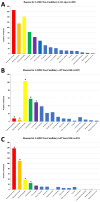Evaluating the Rate and Causes of Non-candidacy After Laser-Assisted in Situ Keratomileusis (LASIK) Screening
- PMID: 40704251
- PMCID: PMC12286648
- DOI: 10.7759/cureus.86618
Evaluating the Rate and Causes of Non-candidacy After Laser-Assisted in Situ Keratomileusis (LASIK) Screening
Abstract
Purpose To provide an updated characterization of the reasons for laser-assisted in situ keratomileusis (LASIK) non-candidacy. Methods A retrospective chart review was conducted on 648 patients (648 right eyes) who presented for LASIK evaluation at a refractive surgery center in Draper, UT, between November 2022 and April 2023. Age, spherical equivalent (SEQ), and keratometry measurements were compared between LASIK candidates and non-candidates. The overall rate of non-candidacy and reasons for exclusion were documented. Subgroup analyses were performed based on age groups, stratifying patients into two cohorts: patients younger than 45 years and those 45 years or older. Results The overall LASIK non-candidacy rate was 69.4%, primarily due to emmetropic presbyopia (36.9%), abnormal topography (31.3%), and hyperopic presbyopia (25.6%). Among patients < 45 years, non-candidacy was often due to abnormal topography (43.5%), corneal thinning (24.5%), and severe myopia (20.7%). Compared to LASIK candidates < 45 years, non-candidates had thinner corneas (548.8 ± 29.0 vs 526.4 ± 33.6 µm; P < 0.001), and steeper corneas, including K1 (42.7 ± 1.6 vs 43.3 ± 1.5 D; P = 0.002) and K2 (43.9 ± 1.6 vs 44.7 ± 1.7 D; P < 0.001). In contrast, for patients ≥ 45, presbyopia (emmetropia: 74.2% and hyperopia: 51.6%) was the leading barrier to qualifying for LASIK. Non-candidates in this cohort showed higher mean age (P = 0.02) and had less myopia (-0.71 ± 3.03 vs -3.40 ± 2.12 D; P < 0.001) compared to their eligible counterparts. Conclusion LASIK remains one of the most thoroughly evaluated refractive procedures, with a proven track record of long-term safety, efficacy, and high patient satisfaction. LASIK non-candidacy was found to be influenced by demographics, with distinct corneal patterns across each subgroup. Patients younger than 45 years were primarily excluded due to abnormal topography, corneal thinning, and severe myopia, while patients 45 and older were more often excluded due to presbyopia, specifically emmetropia and hyperopia. The high non-candidacy rate not only reflects the rigorous screening criteria but also the increased sensitivity of diagnostic devices and the expanding surgical alternatives, such as intraocular lenses with advanced optics for multifocal correction. This allows more patients to achieve greater visual satisfaction than was possible two to three decades ago.
Keywords: corneal refractive surgery; emmetropia; hyperopia; keratoconus; lasik; myopia; ophthalmology; presbyopia; rejection; small incision lenticular extraction (smile).
Copyright © 2025, Jaafar et al.
Conflict of interest statement
Human subjects: Informed consent for treatment and open access publication was obtained or waived by all participants in this study. Biomedical Research Alliance of New York Institutional Review Board issued approval A20-12-547-823. The IRB protocol titled “A Retrospective Analysis of Vision Correction Surgery Outcomes in a Single Practice” is an umbrella approval that covers all retrospective chart reviews at our site involving visual outcomes after refractive procedures. The current study, “Evaluating the Rate and Causes of Non-Candidacy after LASIK Screening,” falls within the scope of this IRB, as it involves a retrospective review of refractive surgery candidates at our institution and evaluates visual outcomes and clinical decision-making. There is no requirement that the manuscript title has to exactly match the IRB title, as long as the study falls within the approved parameters. Animal subjects: All authors have confirmed that this study did not involve animal subjects or tissue. Conflicts of interest: In compliance with the ICMJE uniform disclosure form, all authors declare the following: Payment/services info: All authors have declared that no financial support was received from any organization for the submitted work. Financial relationships: All authors have declared that they have no financial relationships at present or within the previous three years with any organizations that might have an interest in the submitted work. Other relationships: All authors have declared that there are no other relationships or activities that could appear to have influenced the submitted work.
Figures
Similar articles
-
Laser-assisted subepithelial keratectomy (LASEK) versus laser-assisted in-situ keratomileusis (LASIK) for correcting myopia.Cochrane Database Syst Rev. 2017 Feb 15;2(2):CD011080. doi: 10.1002/14651858.CD011080.pub2. Cochrane Database Syst Rev. 2017. PMID: 28197998 Free PMC article.
-
Surgical interventions for presbyopia.Cochrane Database Syst Rev. 2025 Apr 14;4(4):CD015711. doi: 10.1002/14651858.CD015711.pub2. Cochrane Database Syst Rev. 2025. PMID: 40226888
-
[Comparison of visual outcomes between corneal topography-guided FS-LASIK and SMILE for myopia and myopic astigmatism: a network meta-analysis].Zhonghua Yan Ke Za Zhi. 2024 Dec 11;60(12):1004-1012. doi: 10.3760/cma.j.cn112142-20240108-00014. Zhonghua Yan Ke Za Zhi. 2024. PMID: 39648029 Chinese.
-
Laser-assisted subepithelial keratectomy (LASEK) versus photorefractive keratectomy (PRK) for correction of myopia.Cochrane Database Syst Rev. 2016 Feb 22;2(2):CD009799. doi: 10.1002/14651858.CD009799.pub2. Cochrane Database Syst Rev. 2016. PMID: 26899152 Free PMC article.
-
Small Incision Lenticule Extraction (SMILE) Versus Laser Assisted Stromal In Situ Keratomileusis (LASIK) for Astigmatism Corrections: A Systematic Review and Meta-analysis.Am J Ophthalmol. 2023 Mar;247:181-199. doi: 10.1016/j.ajo.2022.11.013. Epub 2022 Nov 19. Am J Ophthalmol. 2023. PMID: 36410469
References
-
- Refractive surgery. Kim TI, Alió Del Barrio JL, Wilkins M, Cochener B, Ang M. Lancet Lond Engl. 2019;393:2085–2098. - PubMed
-
- Complications of corneal refractive surgery. Lindquist TD. Int Ophthalmol Clin. 1992;32:97–114. - PubMed
-
- LASIK vs LASEK vs PRK: advantages and indications. Ambrósio R Jr, Wilson S. Semin Ophthalmol. 2003;18:2–10. - PubMed
-
- Long-term outcomes of PRK, LASIK and SMILE (Article in German) Taneri S, Knepper J, Rost A, Dick HB. Ophthalmologe. 2022;119:163–169. - PubMed
LinkOut - more resources
Full Text Sources
Miscellaneous

